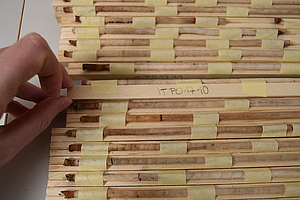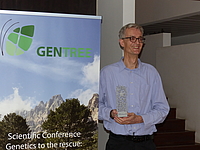
Reading the story of the tree
As part of the GenTree project, the Swiss Federal Institute for Forest, Snow and Landscape Research (WSL) is analysing 15000 samples from 12 tree species collected across all of Europe.
GenTree’s multi-scale tree sampling project resulted in more than 15,000 wood cores from trees sampled all over Europe: 3 cores from 25 trees of 12 species across 200 sites. These cores all ended up at the laboratories of the Swiss Federal Institute for Forest, Snow and Landscape Research (WSL), where the tree rings revealed in the cores are measured and analysed.
“The trees have archived what they were doing in the past,” said Patrick Fonti, team leader in the tree-ring research group at WSL. “By looking at the tree rings you can fly back in time and reconstruct the interaction of the tree with the environment.”
Cores are carefully graded for quality. Those that are less than perfect can still be used to study the anatomy of the wood. The very best, those that are unbroken and that reach the pith (the heart of the tree trunk) are selected for dendrochronology — the study of dated tree rings.
We recognise the familiar tree-ring-pattern in the cut surface of a tree trunk or branch because the wood laid down in early summer, when growth is at its fastest, is usually lighter in colour. The width of the ring laid down each year can reveal much about the climate and other external factors that affect the growth of the tree.
Answers to many questions
The beauty of dendrochronology, according to Patrick Fonti, is that it has value for so many disciplines.
“Everything that trees can perceive and register can be the subject of your research. Everything that changes over time in the environment, tree rings can help you to get answers.”
That may be something like a forest fire, or a flood, and how it affects the growth of the trees.
“Dendrochronology allows you to reconstruct the dynamics of some process,” Fonti says. “You can retrospectively assign dates to events and climatic conditions that otherwise you could not have information on.”
More importantly, perhaps, tree rings offer a long-term perspective. They may, for example, show that with climate change there has been an increase in the frequency of wildfires.
Dendrochronology can also show forest managers how trees have responded to changes in past climates and so help them to select trees for the future. "This is one of the specific things the WSL hopes to contribute to the GenTree project," says Fonti.
“The rings have a very specific language that you have to understand” Fonti adds. “But once you are able to understand that, it really is like reading a book. Every ring is a page, and you go back and read the story of the tree’s life by just observing and reading out what is in the rings.”
Measuring the rings

For accurate dendrochronology, the tree rings must be very carefully identified, measured and dated. The Swiss laboratory is doing that for all 15 thousand samples.
After grading, the researchers glue each core to a wooden strip for support as it is polished on four successively finer grades of sandpaper to make the rings more visible. In many species, such as conifers, the rings are easy to see. They can be analysed directly after polishing.
A computer controls a platform that moves the polished core beneath the lens of a microscope to measure the distance between successive annual rings. The whole process takes just a few minutes for each core.
Some species, including birch and poplar, have less distinct growth rings. For these, researchers use an instrument called a microtome that removes a very thin slice from the surface of the core. This results in an even finer polished surface than sandpaper and so allows the instrument to measure the rings more effectively.
The measurements that provide a profile of the core are accurate to .01 mm. Each tree’s growth pattern, however, is unique. To be useful, the cores have to be cross dated; each ring has to be assigned to the correct calendar year. The profiles of each tree in each plot are matched so that the peaks and troughs align. If they don’t, the measurements have to be repeated.
Rings can also be matched across different species and sites if there was an event with widespread impact. In 1815, for example, the huge volcanic eruption of Mount Tambora in Indonesia threw vast amounts of ash into the atmosphere, making 1816 “the year without a summer”. The effects of the eruption show up in narrow tree rings that year for almost all species everywhere in the northern hemisphere.

